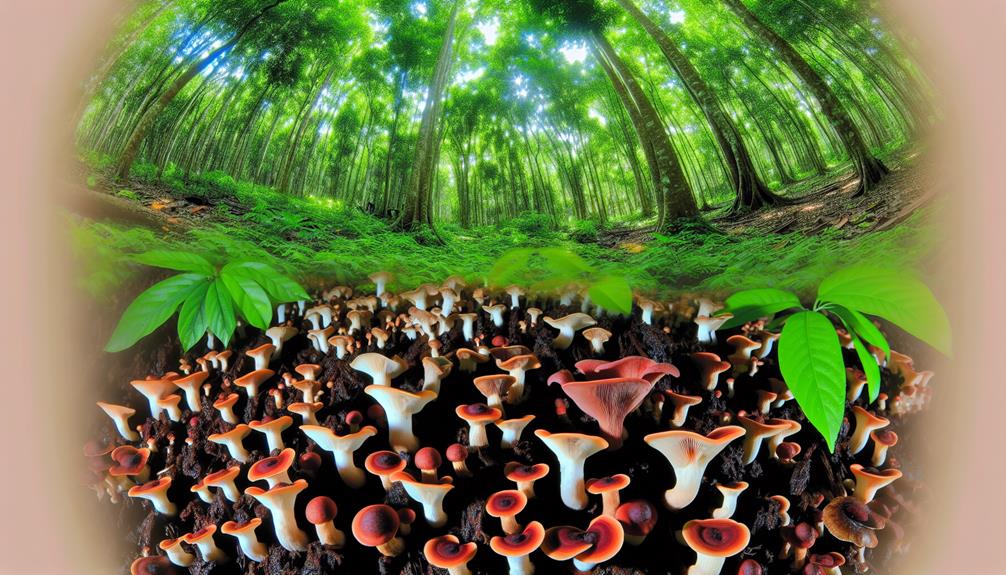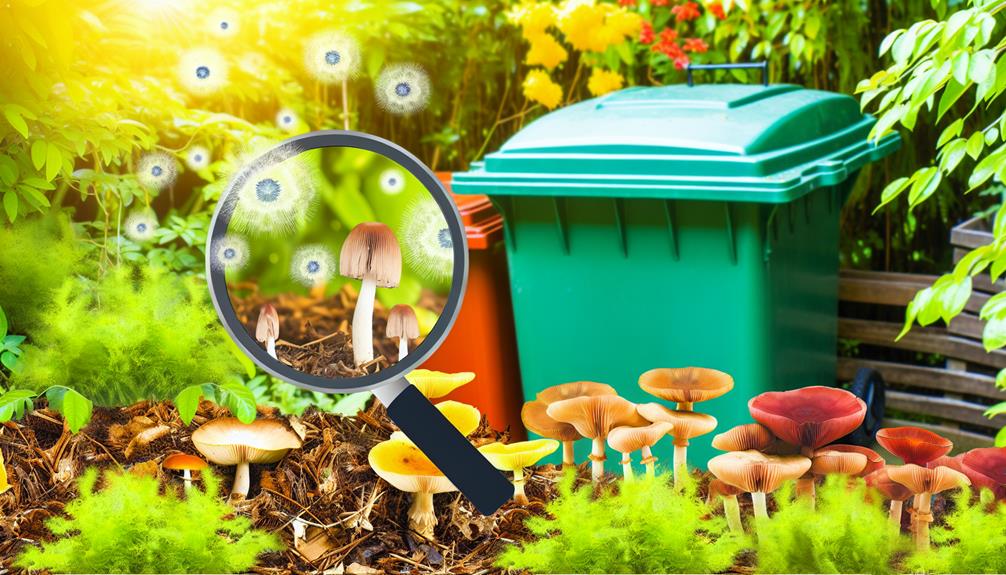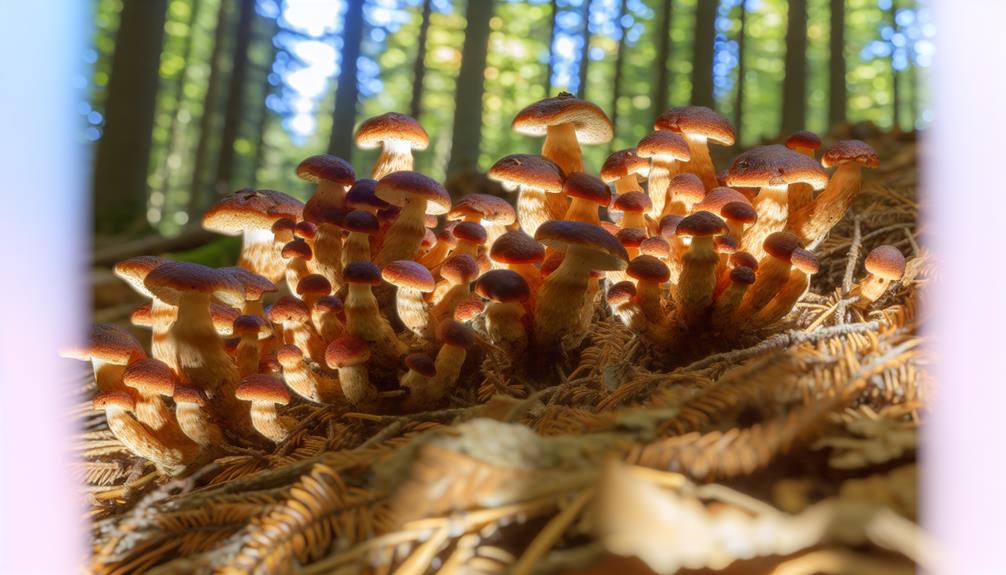

You can compost wild mushrooms to enrich your soil with essential nutrients like nitrogen, phosphorus, and potassium. Mushrooms help decompose organic matter efficiently, enhancing soil structure and moisture retention. However, be cautious of potential risks such as toxicity, spore contamination, and unpredictable decomposition rates.
Guarantee you properly identify and pre-treat mushrooms by drying or heating to kill spores. Regularly monitor and turn your compost pile for best decomposition. By balancing green and brown materials, and maintaining moisture, you’ll create a nutrient-rich compost. To understand the best processes and precautions involved, consider exploring further on this topic.
Composting wild mushrooms can greatly enrich your soil with essential nutrients. By adding mushrooms to your compost, you tap into the power of fungal breakdown, which is excellent for soil enrichment. Mushrooms decompose organic matter efficiently, releasing nutrients like nitrogen, phosphorus, and potassium back into the soil. This process not only nourishes your plants but also improves soil structure, making it more robust and capable of retaining moisture.
To start, gather wild mushrooms and mix them with other compost materials like leaves, grass clippings, and vegetable scraps. This creates a balanced compost heap, ensuring that the fungal breakdown occurs effectively. Turn the pile regularly to aerate it, which speeds up the decomposition process. Mushrooms break down quickly compared to other organic materials, so you’ll notice the benefits sooner.
When the compost is ready, spread it across your garden beds. The enriched soil will foster a thriving plant ecosystem, promoting healthier and more resilient growth.
As you continue this practice, you’ll build a sense of community with fellow gardeners who share your commitment to sustainable, nutrient-rich gardening. Embrace composting wild mushrooms and watch your garden flourish.
There are several types of wild mushrooms that you can use in your composting efforts. Understanding these types helps you maximize the benefits of your compost. Edible varieties like Morels, Chanterelles, and Porcini aren’t only great in the kitchen but also excellent for your compost pile. They break down quickly, enriching your compost with essential nutrients.
When considering habitat preferences, it’s important to know where these mushrooms thrive. Morels typically grow in moist, wooded areas, often around decaying trees. Chanterelles favor well-drained, mossy forests, while Porcini are commonly found near pine and spruce trees. Collecting mushrooms from their natural habitats guarantees you’re adding organic material that decomposes efficiently.
You might come across inedible mushrooms like the Turkey Tail or the Artist’s Conk, which also contribute positively to your compost. These fungi are wood-decomposers, breaking down tough plant material into simpler compounds. Adding them to your compost can help accelerate the breakdown of woody debris.
Also Read: Can You Compost Basil?
When composting wild mushrooms, you need to be aware of several risks. Toxicity concerns are significant since some mushrooms can be poisonous and harmful to your compost.
Additionally, spore contamination and unpredictable decomposition rates can affect the quality and safety of your compost.
Handling wild mushrooms for composting poses several importance risks that you need to be aware of. Many wild mushrooms are toxic, and their toxins can pose significant health hazards if they contaminate your compost. These toxins could potentially transfer to the plants grown in the composted soil, posing risks to both the soil safety and your health.
| Importance Risk | Impact |
|---|---|
| Critical Compounds | Can harm beneficial soil microbes |
| Health Risks | Potential poisoning if ingested |
| Soil Contamination | Long-term soil degradation |
| Harm to Plants | Toxins absorbed by plant roots |
Before adding wild mushrooms to your compost, consider how these toxins interact with your composting system. Certain mushrooms contain compounds that can be harmful not just to humans, but also to beneficial soil organisms. These organisms play an essential role in breaking down organic matter, so their health is paramount for effective composting.
To assure soil safety, always research the species of wild mushrooms you plan to compost. Avoid composting mushrooms if you’re uncertain about their toxicity. It’s better to err on the side of caution and exclude potentially harmful fungi from your compost pile. This practice will help maintain a healthy and safe composting environment.
In addition to toxins, wild mushrooms can introduce spore contamination to your compost, which may lead to unintended consequences. These spores are tiny reproductive units that can spread easily and potentially dominate your compost pile. If not managed properly, spore spread can cause unwanted fungi to grow in your garden, disrupting the balance of your soil ecosystem.
To minimize contamination sources, it’s essential to be selective about the wild mushrooms you add to your compost. Some mushrooms release spores that are particularly aggressive. When these spores mix into your compost, they can outcompete beneficial microorganisms, hindering the composting process.
You can take a few proactive steps to mitigate these risks. First, consider thoroughly drying the mushrooms before composting them, as this can reduce their spore viability. Second, maintain a high compost temperature, ideally between 130-150°F, to kill off most spores. Regularly turning your compost can also help distribute heat evenly, ensuring thorough decomposition and minimizing spore survival.
Decomposing wild mushrooms can lead to unpredictable outcomes, posing potential risks to your compost pile and garden. The decomposition rate of wild mushrooms is highly variable. Some mushrooms break down quickly, while others take much longer. This inconsistency can disrupt the balance of your compost, making it challenging to manage.
One of the main concerns is the fungal activity that wild mushrooms introduce. While fungi are essential for breaking down organic matter, too much fungal activity can overwhelm your compost. This can lead to an imbalance, where the fungi outcompete bacteria and other microorganisms, slowing down the overall decomposition process. You might end up with a compost pile that’s not breaking down as efficiently as it should.
Additionally, some wild mushrooms produce compounds that can be harmful to plants. These compounds might persist in your compost, potentially affecting the health of your garden.
To mitigate these risks, you should monitor the decomposition of wild mushrooms closely. Consider adding them in small amounts and mixing them well with other compost materials. This helps ensure a more balanced decomposition process and minimizes the potential negative impacts on your compost and garden.
Also Read: Can You Compost Celery?
Wild mushrooms can enrich your compost with a variety of essential nutrients. When you add wild mushrooms to your compost pile, you’re not just discarding organic matter; you’re contributing to soil enrichment. Mushrooms are rich in nitrogen, phosphorus, and potassium, which are important for plant growth. As these mushrooms decompose, they release these nutrients, transforming your compost into a potent organic fertilizer.
To maximize the benefits, make sure you’re regularly turning your compost pile. This aerates the mixture and speeds up the breakdown process, helping the mushrooms and other organic materials decompose more efficiently. By doing this, you create a more uniform compost that’s rich in nutrients.
One tip to remember is to chop larger mushrooms into smaller pieces before adding them to your compost. This increases the surface area and speeds up decomposition, ensuring the nutrients are more quickly available for your plants.
Additionally, mixing mushrooms with other green and brown materials—like vegetable scraps and dry leaves—creates a balanced compost pile that improves overall soil health.
One concern when composting wild mushrooms is the importance for spore contamination. Spores are the reproductive units of mushrooms, and they can easily spread if not managed properly. When you add wild mushrooms to your compost, there’s a risk that these spores might proliferate and lead to an unwanted mushroom spread in your garden or compost bin.

To maintain contamination control, you need to be vigilant. First, make sure that the wild mushrooms you collect are properly identified, as some species can be invasive.
Next, consider pre-treating the mushrooms by drying them out or heating them to kill off any viable spores. This step helps to prevent the spread of mushroom spores into your compost and ultimately your garden.
It’s also important to monitor the compost pile regularly. Turn it frequently to maintain high temperatures, as heat can help inactivate many spores. If you notice any unusual mushroom growth, remove those sections immediately to prevent further contamination.
Also Read: Can You Compost Black-Eyed Peas?
To compost wild mushrooms effectively, start by choosing suitable materials like vegetable scraps and yard waste.
Balance the carbon and nitrogen ratio by mixing brown materials, such as leaves, with green ones, like kitchen scraps.
Keep the compost moist but not soggy to maintain ideal conditions for decomposition.
Selecting the right materials is essential for successful composting of wild mushrooms. Start by choosing a compost bin that suits your space and needs. Tumbling bins are excellent because they simplify the process of turning the pile, which is important for aeration and speeding up decomposition. If you prefer, a stationary bin can work too, but you’ll need to manually turn the pile with a pitchfork or shovel.
When it comes to materials, aim for a good mix of green and brown waste. Green waste includes your wild mushrooms, fruit and vegetable scraps, and fresh grass clippings. These items are rich in nitrogen and help to heat up the compost pile. Brown waste, such as dried leaves, straw, and cardboard, adds carbon and is essential for providing structure and aeration.
Avoid adding meat, dairy, or oily foods as they can attract pests and cause odors. Make sure to chop larger items into smaller pieces to accelerate decomposition. Keep your pile moist but not waterlogged, like a damp sponge.
Regularly turning the pile ensures even breakdown and prevents unpleasant smells, fostering a thriving compost community.
Achieving the right balance of carbon and nitrogen in your compost pile is essential for efficient decomposition and healthy compost. You want to aim for a carbon to nitrogen ratio (C:N) of about 30:1. This ratio guarantees that microorganisms can break down materials effectively, creating a nutrient-rich compost.
Carbon sources typically include dry, brown materials like leaves, straw, and cardboard. These materials provide energy for microorganisms. Nitrogen sources, on the other hand, are often green and moist, like kitchen scraps, grass clippings, and, of course, wild mushrooms. These add essential proteins and amino acids.
Here’s a quick reference table to help you manage your compost:
| Material | Type |
|---|---|
| Fallen leaves | Carbon |
| Straw | Carbon |
| Cardboard | Carbon |
| Kitchen scraps | Nitrogen |
| Grass clippings | Nitrogen |
Mixing these materials in the right proportions will keep your compost pile active. For every bucket of nitrogen-rich material, add two to three buckets of carbon-rich material. Adjusting these ratios helps maintain the ideal environment for decomposition. Remember, a well-balanced compost pile not only breaks down faster but also produces higher quality compost for your garden.
Maintaining ideal moisture in your compost pile guarantees that microorganisms can thrive and decompose materials efficiently. To achieve this, you’ll need to keep an eye on the moisture levels, ensuring they’re neither too dry nor too wet. Think of your compost pile like a damp sponge—moist but not dripping.
Start by regularly checking your compost’s hydration. If it’s too dry, lightly water it and mix thoroughly to distribute the moisture evenly. On the other hand, if it’s too wet, add dry materials like straw or shredded newspaper to absorb the excess water. Turning your compost regularly helps maintain even moisture throughout the pile.
Effective hydration management involves adjusting based on weather conditions. During hot, dry spells, your compost will need more frequent watering. In contrast, during rainy periods, you may need to cover your compost to prevent it from becoming waterlogged.
Also Read: Can You Compost Blood?
Recognizing safe mushrooms is essential to make sure you’re composting non-toxic varieties. One of the first steps you should take is to use a reliable field guide. This guide will offer detailed descriptions and images, helping you differentiate between safe and harmful mushrooms. It’s important to remember that some toxic mushrooms closely resemble edible or harmless ones, so don’t rush the identification process.

In addition to a field guide, consider expert consultation. Speaking with a mycologist or joining a local mushroom foraging group can provide valuable insights. These experts can confirm your identifications and teach you about local mushroom varieties in your area. This kind of community involvement not only enhances your knowledge but also gives you a sense of belonging among fellow enthusiasts.
When identifying mushrooms, pay attention to key features like cap shape, gill structure, and spore color. Take notes and photos to document your findings, comparing them with your field guide.
Always err on the side of caution; if you’re uncertain about a mushroom’s safety, it’s best to avoid composting it. By taking these precautions, you’ll make sure your compost remains safe and beneficial for your garden.
Also Read: Can You Compost Body Wash?
Mushrooms aren’t just for composting; you can explore various alternative uses that benefit your home and garden. One of the most rewarding ways to use mushrooms is in culinary applications. Whether you’re adding them to a hearty stew, sautéing them as a side dish, or crafting a gourmet mushroom risotto, their unique flavors and textures can elevate your meals. Wild mushrooms, in particular, bring a rich, earthy taste that cultivated varieties often lack.
Beyond the kitchen, mushrooms offer medicinal benefits that have been valued for centuries. Certain species like reishi and lion’s mane have properties that support immune health and cognitive function. You can find these mushrooms in supplements, teas, and extracts, making it easy to integrate their health benefits into your daily routine.
If you’re into gardening, consider using mushrooms as natural fertilizers or pest repellents. Their mycelium networks break down organic matter, enriching the soil and promoting plant growth. Some types even deter harmful insects, protecting your plants without the need for chemical pesticides.
Yes, wild mushrooms can cause pest attraction in your compost bin. It’s important to monitor your compost and mix materials well to discourage pests, ensuring your composting community remains healthy and welcoming.
Wild mushrooms decompose quickly, typically within a few weeks, due to their high decomposition rate and robust fungal activity. You’ll see them breaking down fast, enriching your compost, and contributing to a thriving community garden.
Yes, wild mushrooms can affect the compost odor. Their fungal interactions often help break down organic material faster, but they might create a stronger, earthy smell. Don’t worry; it’s a natural part of the composting process.
You can compost mushrooms that are past their prime. Their nutrient content boosts your compost, and their decomposition speed is fast, helping you create rich soil quickly. Including them makes your composting effort even more effective and rewarding.
You should avoid composting mushrooms from unknown origins due to toxicity concerns and the risk of pathogen transmission. It’s safer to stick with mushrooms you recognize to guarantee the health of your community compost.
In conclusion, you can compost wild mushrooms, but be mindful of the potential risks. Make sure you identify mushrooms correctly to avoid introducing harmful spores.
Proper composting techniques are essential to maximize nutrient benefits while minimizing contamination. If you’re unsure about the safety of wild mushrooms, consider alternative uses like mulching or soil amendment.
Always stay informed and cautious to make the most of your composting efforts. By doing so, you’ll enrich your soil effectively and safely.
